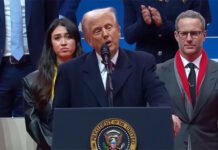INVC international Desk l Washington l
As the world watches US President Donald Trump continue to assert his aggressive stance on global diplomacy, his controversial statements and policies remain at the forefront of international discussions. Known for his bold approach to foreign relations, Trump’s remarks about Canada becoming the 51st state and his unwavering position on US-China trade relations are stirring up significant debate. These developments, coupled with Trump’s ongoing trade negotiations with several countries, have profound implications for global economies.
The Persistent Call for Canada as the 51st US State
One of the more unconventional and polarizing stances of President Trump has been his continued belief that Canada would benefit from becoming the 51st state of the United States. While many critics have dismissed this idea as outlandish, Trump has not wavered in his conviction, suggesting that Canadians would reap significant economic and defense benefits by joining the US.
White House Press Secretary Caroline Levitt recently reiterated this position in a briefing, stating that Canada’s defense spending is heavily subsidized by the United States and that joining the Union could provide a stronger economic foundation for the Canadian people.
“President Trump believes that Canada stands to gain immensely from being part of the US, both in terms of security and economic prosperity,” Levitt said, further emphasizing that Trump’s administration is dedicated to ensuring that American workers are prioritized in any trade agreement.
While this idea is far from realistic in the near term, it highlights Trump’s ongoing focus on reshaping global relationships through bold and often divisive proposals.
Trump’s Unyielding Stance on US-China Trade Relations
The US-China trade war has been one of the defining issues of Trump’s presidency, and recent statements signal that this conflict is far from over. The US administration has made it clear that any future trade talks with China hinge on China taking the first step. White House Press Secretary Levitt, in a recent statement, reiterated that while the US remains open to negotiations, the initiative must come from China.
“The ball is in China’s court. For any meaningful trade talks to take place, China must make the first move,” Levitt stated. “We have already engaged in numerous trade agreements with other countries, and China knows that the US is ready to engage in discussions when they are prepared to act.”
Trump’s approach to China has been marked by tough rhetoric and high tariffs, but his administration has also pursued multiple trade deals globally. While tensions remain high, Levitt stressed that the US is not simply waiting for China but is actively engaging with other nations. Over 75 countries have approached the US with proposals, highlighting the growing appeal of America’s trade policies under Trump’s leadership.
Global Repercussions: The Economic Ramifications of Trump’s Stance
Trump’s trade policies are reshaping global economic alliances. The President’s approach has undeniably shifted the dynamics of international trade, with his “America First” doctrine leading to a more transactional view of foreign relations. Under this framework, the US is not just seeking allies but insisting on tangible benefits for American workers, leading to the renegotiation of longstanding trade agreements and the creation of new deals.
While critics argue that Trump’s protectionist policies could isolate the US and damage its global standing, supporters claim that the President’s focus on fair trade is revitalizing the American economy and securing better deals for American businesses.
The White House’s refusal to back down on issues like tariffs and defense contributions signals that the US under Trump is willing to risk international friction to secure what it believes are more equitable arrangements.
The Road Ahead: Will China Yield to Trump’s Demands?
The central question now is whether China will take the first step in resolving the trade dispute. The pressure on China to move first is considerable, as the US has already made substantial progress in its negotiations with other nations. With over 15 trade deals in the works, the US is positioning itself as an attractive trade partner for countries eager to engage in mutually beneficial agreements.
However, China has made it clear that it will not be easily swayed by external pressure. Whether or not Beijing is willing to compromise remains a crucial factor in determining the future of US-China relations. As tensions between the two economic giants continue to simmer, global markets remain on edge, uncertain about the direction of the trade war.
Trump’s Global Trade Agenda: A Shift in the World Order
In many ways, Trump’s foreign policy marks a shift in the global order. No longer are nations assuming that trade relationships will proceed along traditional lines. Instead, the President’s aggressive posture has set the stage for a rethinking of what international trade should look like in the 21st century. By focusing on fairness, reciprocity, and putting American workers at the forefront, Trump’s policies are both challenging and redefining global economic norms.
As negotiations continue across the globe, the long-term impact of Trump’s policies remains to be seen. Whether these bold moves lead to a new era of prosperity for the US and its allies or spark further global division remains one of the key questions of this presidency.
Conclusion: Trump’s Legacy on Global Trade
While Trump’s policies continue to polarize opinion, one thing is clear: his legacy will include a major recalibration of the global trade landscape. Whether advocating for Canada’s integration as a US state or pressing China to make the first move in trade negotiations, Trump’s approach is anything but typical. With the world watching, it remains to be seen how these bold strategies will shape the future of international diplomacy and trade.
















